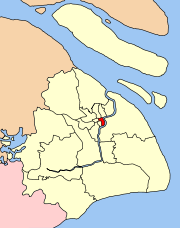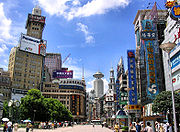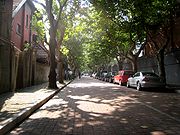
Huangpu District, Shanghai
Encyclopedia

Shanghai
Shanghai is the largest city by population in China and the largest city proper in the world. It is one of the four province-level municipalities in the People's Republic of China, with a total population of over 23 million as of 2010...
's 18 districts and makes up the eastern part of Shanghai's traditional urban core. Today's Huangpu District is sometimes referred to as "new Huangpu" to distinguish it from the pre-merger Huangpu District which existed before 2000. In 2000, the pre-merger Huangpu and Nanshi districts were combined to form a new district, also called Huangpu. In June 2011, the existing Huangpu District was combined with Luwan District
Luwan District
Luwan District was a district located in central Shanghai, China until its merger with Huangpu District, Shanghai in June 2011. It had an area of 8.05 km² and population of 350,000 as of 2001.- Location :...
to form a further new district, again called Huangpu. As a result of this merger, it currently has an area of 20.43 km² and 678,670 inhabitants (as of 2010 census). Huangpu is one of the most densely populated urban districts in the world.
Location
Huangpu is located in central ShanghaiShanghai
Shanghai is the largest city by population in China and the largest city proper in the world. It is one of the four province-level municipalities in the People's Republic of China, with a total population of over 23 million as of 2010...
, People's Republic of China
People's Republic of China
China , officially the People's Republic of China , is the most populous country in the world, with over 1.3 billion citizens. Located in East Asia, the country covers approximately 9.6 million square kilometres...
on the left bank (i.e. west or north bank) of Huangpu river
Huangpu River
The Huangpu River is a -long river in China flowing through Shanghai...
, after which the district is named. It is opposite to Pudong
Pudong
Pudong |Bank]]") is an area of Shanghai, China, located along the east side of the Huangpu River, across from the historic city center of Shanghai in Puxi. Formerly a little-developed agricultural area linked only by ferries, Pudong has grown rapidly since the 1990s and emerged as China's financial...
and is bounded by Suzhou Creek
Suzhou Creek
Suzhou Creek is a river in China that passes through the Shanghai city centre. It is named after Suzhou, a city in neighbouring Jiangsu province which was the predominant city in this area prior to the rise of Shanghai as a metropolis.One of the principal outlets of Lake Tai, Suzhou Creek has a...
to the north.
Of the three previous districts that make up today's Huangpu, the pre-merger Huangpu is located to the north, bounded by Suzhou Creek in the north and the Huangpu River to the east. South of the per-merger Huangpu district was Nanshi District, bounded by the Huangpu River to the east. West of Nanshi District was Luwan District, bounded by the Huangpu River to the south.
History
Today's Huangpu district is the result of the merger of three long-standing districts of Shanghai, Nanshi, Huangpu and Luwan. Each of these have a distinct history and character.Nanshi

Huangpu River
The Huangpu River is a -long river in China flowing through Shanghai...
. Shanghai County was established at the beginning of the Ming Dynasty
Ming Dynasty
The Ming Dynasty, also Empire of the Great Ming, was the ruling dynasty of China from 1368 to 1644, following the collapse of the Mongol-led Yuan Dynasty. The Ming, "one of the greatest eras of orderly government and social stability in human history", was the last dynasty in China ruled by ethnic...
. A city wall was built to repel the Wokou
Wokou
Wokou , which literally translates as "Japanese pirates" in English, were pirates of varying origins who raided the coastlines of China and Korea from the 13th century onwards...
, and this Ming Dynasty wall defined the extent of urban Shanghai for the next few centuries. In 1842, the area north of the old city was established as the British concession in Shanghai, which alter became the Shanghai International Settlement
Shanghai International Settlement
The Shanghai International Settlement began originally as a purely British settlement. It was one of the original five treaty ports which were established under the terms of the Treaty of Nanking at the end of the first opium war in the year 1842...
. At the time, the concession was referred to by locals as the "northern city" while the walled Chinese city was the "southern city". From this reference was later derived the name Nanshi . Upon the defeat of Japan at the end of World War II
World War II
World War II, or the Second World War , was a global conflict lasting from 1939 to 1945, involving most of the world's nations—including all of the great powers—eventually forming two opposing military alliances: the Allies and the Axis...
, a unified municipal administration was established over urban Shanghai for the first time since the mid 19th century. In 1945, after the Republic of China
Republic of China
The Republic of China , commonly known as Taiwan , is a unitary sovereign state located in East Asia. Originally based in mainland China, the Republic of China currently governs the island of Taiwan , which forms over 99% of its current territory, as well as Penghu, Kinmen, Matsu and other minor...
government took control, the old city was divided into the Third District (Yimiao District) and the Fourth District (Penglai). In 1959 these were merged to form Nanshi district (with a small part of former Yimiao District merging into Luwan District).
Huangpu

Shanghai International Settlement
The Shanghai International Settlement began originally as a purely British settlement. It was one of the original five treaty ports which were established under the terms of the Treaty of Nanking at the end of the first opium war in the year 1842...
. In the later part of the 19th century and the early 20th century, this area quickly became the commercial centre of Shanghai. The International Settlement was handed back to the Chinese government in 1943. In 1945, after the Republic of China
Republic of China
The Republic of China , commonly known as Taiwan , is a unitary sovereign state located in East Asia. Originally based in mainland China, the Republic of China currently governs the island of Taiwan , which forms over 99% of its current territory, as well as Penghu, Kinmen, Matsu and other minor...
government took control, the south eastern part of the former International Settlement was divided into the First Distrct (Huangpu District) and the Second District (Laozha). Of these, the First Distrct lay on the bank of the Huangpu River
Huangpu River
The Huangpu River is a -long river in China flowing through Shanghai...
, and so was named after the river. In 1956, the two districts were merged to form a new Huangpu District.
Since 1943, the Shanghai Municipal Government has always been located in Huangpu District - first at the old Shanghai Municipal Council building, then in the old HSBC Building
HSBC Building, Shanghai
The HSBC Building is a six-floor neo-classical building in the Bund area of Shanghai, China. It was the headquarters of the Shanghai branch of The Hongkong and Shanghai Banking Corporation from 1923 to 1955. The building is situated at number 12, the Bund. It is also known as the Municipal...
, and presently in a purpose-built building on People's Square
People's Square (Shanghai)
People's Square is a large public square adjacent to Nanjing Road in the Huangpu District of Shanghai, China. People's Square is the site of Shanghai's municipal government headquarter building, and is used as the standard reference point for measurement of distance in the Shanghai...
.
Luwan

Shanghai French Concession
The Shanghai French Concession was a foreign concession in Shanghai, China from 1849 until 1946, and it was progressively expanded in the late 19th and early 20th centuries. The concession came to an end in practice in 1943 when the Vichy French government signed it over to the pro-Japanese puppet...
and some nearby areas. This area was long regarded as the premier residential and high end commercial area of Shanghai. It is known for its leafy streets lined with London plane
London Plane
Platanus × acerifolia, the London plane, London planetree, or hybrid plane, is a tree in the genus Platanus. It is usually thought to be a hybrid of Platanus orientalis and the Platanus occidentalis . Some authorities think that it may be a cultivar of P...
s, cafes and restaurants, high end retail and historical houses. In 1945, after the Republic of China
Republic of China
The Republic of China , commonly known as Taiwan , is a unitary sovereign state located in East Asia. Originally based in mainland China, the Republic of China currently governs the island of Taiwan , which forms over 99% of its current territory, as well as Penghu, Kinmen, Matsu and other minor...
government took control, the eastern-central part of the former French Concession was divided into the Fifth District (Taishan) and the Sixth District (Lujiawan), separated by South Chongqing Road and Luban Road. Of these, the Sixth District was named after Lokawei , "Lu's Bay", an area named after a bend on the Zhaojiabang creek. The main police depot and prison of the French concession was located here. In 1947, Taishan District was renamed "Songshan District". In 1950, Lujiawan District was renamed "Luwan District". In 1956, Songshan District was merged into Luwan District. In 1959, part of former Yimiao District was also merged into Luwan District.
Merger in the 1990s and 2000s
The district boundaries remained largely unchanged between 1959 and 1993. In 1993, the part of Nanshi east of the Huangpu River was merged into the PudongPudong
Pudong |Bank]]") is an area of Shanghai, China, located along the east side of the Huangpu River, across from the historic city center of Shanghai in Puxi. Formerly a little-developed agricultural area linked only by ferries, Pudong has grown rapidly since the 1990s and emerged as China's financial...
New District. In 2000, the Shanghai Municipal Government abolished Nanshi district entirely, merging it into the Huangpu district. In 2011, the merger of Luwan District with Huanpu District was announced. On June 8th 2011, it was announced that the proposed plan of merging Luwan and Huangpu districts had been approved by the State Council
State Council of the People's Republic of China
The State Council of the People's Republic of China , which is largely synonymous with the Central People's Government after 1954, is the chief administrative authority of the People's Republic of China. It is chaired by the Premier and includes the heads of each governmental department and agency...
.
Features
Despite the mergers, the three previous districts which make up today's Huangpu District retain their distinct characters.Huangpu
The pre-merger Huangpu District was long the commercial centre of Shanghai. Along the Huangpu riverfront were located the major docks of Shanghai. Dongmen StreetDongmen Street
Dongmen Street, located in Huangpu District, Shanghai, China, extends west from Zhonghua Road and east to the Bund of Huangpu River, and is crossed by the South Zhongshan Road, one of the main traffic roads in downtown Shanghai.-History:...
extends west from Zhonghua Road and east to the Bund
The Bund
The Bund is a waterfront area in central Shanghai, People's Republic of China. The area centres on a section of Zhongshan Road within the former Shanghai International Settlement, which runs along the western bank of the Huangpu River, facing Pudong, in the eastern part of Huangpu District...
of Huangpu River, and is crossed by the South Zhongshan Road. Behind the district, on the Bund
The Bund
The Bund is a waterfront area in central Shanghai, People's Republic of China. The area centres on a section of Zhongshan Road within the former Shanghai International Settlement, which runs along the western bank of the Huangpu River, facing Pudong, in the eastern part of Huangpu District...
, are offices of major financial institutions and trading houses. Extending from the Bund westward are several major commercial streets. These include the East Nanjing Road, popular with visitors from around the country. Fuzhou Road is the centre of bookselling in Shanghai, featuring large scale general and specialist book shops and publishers.
The People's Square
People's Square (Shanghai)
People's Square is a large public square adjacent to Nanjing Road in the Huangpu District of Shanghai, China. People's Square is the site of Shanghai's municipal government headquarter building, and is used as the standard reference point for measurement of distance in the Shanghai...
, previously the Shanghai race course, is now the site of the Shanghai Grand Theatre
Shanghai Grand Theatre
The Shanghai Grand Theatre is located at the intersection of Central Boulevard and Huangpi Road South in northern part of the People's Square in Huangpu District, Shanghai, China....
, Shanghai Museum
Shanghai Museum
The Shanghai Museum is a museum of ancient Chinese art, situated on the People's Square in the Huangpu District of Shanghai, People's Republic of China.-History:...
, Shanghai Art Museum
Shanghai Art Museum
The Shanghai Art Museum is an art museum in the city of Shanghai, China. It is located in the former clubhouse building of the Today, it is the home of the Shanghai biennial and stands adjacent to People's Square...
, and the Shanghai Urban Planning Exhibition Hall
Shanghai Urban Planning Exhibition Hall
The Shanghai Urban Planning Exhibition Center is located on People's Square, Shanghai, China, adjacent to the municipal government building....
. The Shanghai Natural History Museum
Shanghai Natural History Museum
The Shanghai Natural History Museum is a museum dedicated to natural history. It is one of the largest museums of natural sciences in China.-History:...
is also located in Huangpu District.
Nanshi
The old Nanshi district is the old, walled city of Shanghai, and retains a number of important sights, including City God Temple and the nearby Yuyuan Garden. The old city is undergoing extensive redevelopment, with the existing houses being replaced by high rise apartment buildings as well as modern constructions with traditional Chinese style facades. The boundaries of the walled city can still be traced in the form of a wide ring road built over the course of the old city wall and moat. The city wall has almost entirely been demolished, except for one tower and a short section of wall attached to it, which survived because the tower was converted into a temple in the medieval period.Luwan
The old Luwan district was a part of the old French Concession area, traditionally one of the most prestigious sections of the city. It was famous for its boulevards lined with plane treeLondon Plane
Platanus × acerifolia, the London plane, London planetree, or hybrid plane, is a tree in the genus Platanus. It is usually thought to be a hybrid of Platanus orientalis and the Platanus occidentalis . Some authorities think that it may be a cultivar of P...
s, which had been imported over 100 years ago. Despite rampant redevelopment, the district retains a distinct character and is a tourist attraction in itself. The district included the historical residences of Sun Yat-sen
Sun Yat-sen
Sun Yat-sen was a Chinese doctor, revolutionary and political leader. As the foremost pioneer of Nationalist China, Sun is frequently referred to as the "Father of the Nation" , a view agreed upon by both the People's Republic of China and the Republic of China...
, Mao Zedong
Mao Zedong
Mao Zedong, also transliterated as Mao Tse-tung , and commonly referred to as Chairman Mao , was a Chinese Communist revolutionary, guerrilla warfare strategist, Marxist political philosopher, and leader of the Chinese Revolution...
, Zhou Enlai
Zhou Enlai
Zhou Enlai was the first Premier of the People's Republic of China, serving from October 1949 until his death in January 1976...
, Agnes Smedley
Agnes Smedley
Agnes Smedley was an American journalist and writer best known for her semi-autobiographical novelDaughter of Earth. She was also known for her sympathetic chronicling of the Chinese revolution...
and Mei Lanfang
Méi Lánfang
Mei Lanfang was one of the most famous Beijing opera artists in modern history, exclusively known for his qingyi roles, a type of dan role. Méi Lánfāng is his stage name, and in Chinese it is generally considered a feminine name. His real name was Méi Lán...
, among many others.

